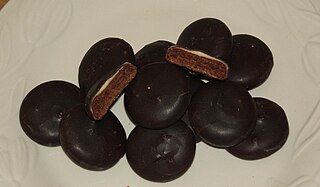Related Research Articles

A cookie, or a biscuit, is a baked or cooked snack or dessert that is typically small, flat and sweet. It usually contains flour, sugar, egg, and some type of oil, fat, or butter. It may include other ingredients such as raisins, oats, chocolate chips, nuts, etc.
Dieting is the practice of eating food in a regulated way to decrease, maintain, or increase body weight, or to prevent and treat diseases such as diabetes and obesity. As weight loss depends on calorie intake, different kinds of calorie-reduced diets, such as those emphasising particular macronutrients, have been shown to be no more effective than one another. As weight regain is common, diet success is best predicted by long-term adherence. Regardless, the outcome of a diet can vary widely depending on the individual.

"Junk food" is a term used to describe food that is high in calories from sugar and/or fat, and possibly sodium, but with little dietary fiber, protein, vitamins, minerals, or other important forms of nutritional value. It is also known as HFSS food. The term junk food is a pejorative dating back to the 1950s.

The French paradox is an apparently paradoxical epidemiological observation that French people have a relatively low incidence of coronary heart disease (CHD), while having a diet relatively rich in saturated fats, in apparent contradiction to the widely held belief that the high consumption of such fats is a risk factor for CHD. The paradox is that if the thesis linking saturated fats to CHD is valid, the French ought to have a higher rate of CHD than comparable countries where the per capita consumption of such fats is lower.

Olestra is a fat substitute that adds no calories to products. It has been used in the preparation of otherwise high-fat foods thereby lowering or eliminating their fat content. The Food and Drug Administration (FDA) originally approved olestra for use in the US as a replacement for fats and oils in prepackaged ready-to-eat snacks in 1996, concluding that such use "meets the safety standard for food additives, reasonable certainty of no harm". In the late 2000s, olestra lost its popularity due to supposed side effects and has been largely phased out, but products containing the ingredient can still be purchased at grocery stores in some countries.
The Zone diet is a fad diet emphasizing low-carbohydrate consumption. It was created by Barry Sears, an American biochemist.

The Center for Science in the Public Interest (CSPI) is a Washington, D.C.-based non-profit watchdog and consumer advocacy group that advocates for safer and healthier foods.
The Montignac diet is a high-protein low-carbohydrate fad diet that was popular in the 1990s, mainly in Europe. It was invented by Frenchman Michel Montignac (1944–2010), an international executive for the pharmaceutical industry, who, like his father, was overweight in his youth. His method is aimed at people wishing to lose weight efficiently and lastingly, reduce risks of heart failure, and prevent diabetes.

SnackWell's was an American brand of foods that was introduced in 1992. Its products used to include fat-free cookies of a variety of flavors including creme, shortbread, and devil's food cake. Previously a Nabisco brand, it was later sold to Back to Nature Foods. In 2022, the SnackWell's brand was retired.
In conservation and energy economics, the rebound effect is the reduction in expected gains from new technologies that increase the efficiency of resource use, because of behavioral or other systemic responses. These responses diminish the beneficial effects of the new technology or other measures taken. A definition of the rebound effect is provided by Thiesen et al. (2008) as, “the rebound effect deals with the fact that improvements in efficiency often lead to cost reductions that provide the possibility to buy more of the improved product or other products or services.” A classic example from this perspective is a driver who substitutes a vehicle with a fuel-efficient version, only to reap the benefits of its lower operating expenses to commute longer and more frequently."
Nutrition transition is the shift in dietary consumption and energy expenditure that coincides with economic, demographic, and epidemiological changes. Specifically the term is used for the transition of developing countries from traditional diets high in cereal and fiber to more Western pattern diets high in sugars, fat, and animal-source food.
Sustainable diets are "dietary patterns that promote all dimensions of individuals’ health and wellbeing; have low environmental pressure and impact; are accessible, affordable, safe and equitable; and are culturally acceptable". These diets are nutritious, eco-friendly, economically sustainable, and accessible to people of various socioeconomic backgrounds. Sustainable diets attempt to address nutrient deficiencies and excesses, while accounting for ecological phenomena such as climate change, loss of biodiversity and land degradation. These diets are comparable to the climatarian diet, with the added domains of economic sustainability and accessiblity.
Obesity in Mexico is a relatively recent phenomenon, having been widespread since the 1980s with the introduction of processed food into much of the Mexican food market. Prior to that, dietary issues were limited to under and malnutrition, which is still a problem in various parts of the country. Following trends already ongoing in other parts of the world, Mexicans have been foregoing the traditional Mexican diet high in whole grains, fruits, legumes and vegetables in favor of a diet with more animal products and processed foods. It has seen dietary energy intake and rates of overweight and obese people rise with seven out of ten at least overweight and a third clinically obese.

Cookie Monster is a blue Muppet character on the long-running PBS/HBO children's television show Sesame Street. In a song in 2004, and later in an interview in 2017, Cookie Monster revealed his real name as "Sid". He is best known for his voracious appetite and his famous eating catchphrases, such as "Me want cookie!" As his name suggests, his preferred food is cookies; though he eats almost anything, including inedible objects. Chocolate chip cookies are his favorite kind. His speech is often grammatically incorrect; he always uses "Me" to refer to himself in place of "I","My", and "Mine". Despite his voracious appetite for cookies, Cookie Monster shows awareness of healthy eating habits for young children and also enjoys fruits and vegetables.
Research into food choice investigates how people select the food they eat. An interdisciplinary topic, food choice comprises psychological and sociological aspects, economic issues and sensory aspects.

Sensory specific satiety is a sensory hedonic phenomenon that refers to the declining satisfaction generated by the consumption of a certain type of food, and the consequent renewal in appetite resulting from the exposure to a new flavour or food. The phenomenon was first described in 1956 by the French physiologist Jacques Le Magnen. The term "sensory specific satiety" was coined in 1981 by Barbara J. Rolls and Edmund T. Rolls. The concept illustrates the role of physical stimuli in generating appetite and, more specifically, explains the significance of taste, or food flavour in relation to hunger. Besides conditioned satiety and alimentary alliesthesia, it is one of the three major phenomena of satiation. An Ingestive Classics paper on the topic has been written in conversation with Barbara J. Rolls
School meal programs in the United States provide school meals free of charge, or at a government-subsidized price, to U.S. students from low-income families. These free or subsidized meals have the potential to increase household food security, which can improve children's health and expand their educational opportunities. A study of a free school meal program in the United States found that providing free meals to elementary and middle school children in areas characterized by high food insecurity led to increased school discipline among the students.

Obesity is defined as the excessive accumulation of fat and is predominantly caused when there is an energy imbalance between calorie consumption and calorie expenditure. Childhood obesity is becoming an increasing concern worldwide, and Australia alone recognizes that 1 in 4 children are either overweight or obese.
Korean baked goods consist of Korean-style bread, buns, pastries, cakes, and snacks. Korean bread did not enter Korean diets or become a mainstream staple until the late 1980s. To a large extent, bread was not part of Korean cuisine, other than some types of traditional steamed bread that were made of mixed rice flour and wheat. Korean breads were first introduced to the mainstream market in the 1980s with the establishment of the bakery chain Paris Baguette. The items that were introduced to the Korean market aimed to introduce a French-inspired type of bread that would simultaneously satisfy a Korean taste palette. Hence, the type of bread and buns that were created were a fusion of Western technique and Korean flavours. Western fused breads are a growing phenomenon across Asia and as new Asian bakery chains grew in their home countries, they have simultaneously entered international markets.
References
- ↑ "One reason I've suggested is what called the SnackWell's Phenomenon: By giving a free pass to good nutrients, people go there and eat a lot more food. If one SnackWell's is okay because it's low-fat, a whole box is probably better." -- Food writer Michael Pollan in his Otis Lecture at Bates College, Oct. 27, 2008.
- ↑ "Buzzword: Snackwell's effect". Archived from the original on 2011-09-05. Retrieved 2012-05-31.
- ↑ Harris, Dena (2015). The Paleo Vegetarian Diet: A Guide For Weight Loss And Healthy Living. Berkeley, CA: Ulysses Press. p. 18. ISBN 9781612434629.
- ↑ Small, Ernest (2009). Top 100 Food Plants . Ottawa: NRC Research Press. pp. 174. ISBN 9780660198583.
- ↑ Jacobson, Michael F. (2017-03-06). "Burying the Snackwell Myth". Medium. Retrieved 2019-09-30.
- ↑ Lucas W. Davis: 'Durable Goods and Residential Demand for Energy and Water: Evidence from a Field Trial'. The RAND Journal of Economics Vol. 39, No. 2 (Summer 2008), pp. 530-546. https://www.jstor.org/stable/25474381
- ↑ "Flex Your Power Energy News - Power Plug » the Snackwell Effect: Consumers Sabotage Energy-Saving Efforts". Archived from the original on 2010-03-26. Retrieved 2010-02-20.
- ↑ Watson, Traci (2009-03-22). "Consumers can sabotage energy-saving efforts". USA Today . Archived from the original on 2011-06-04.